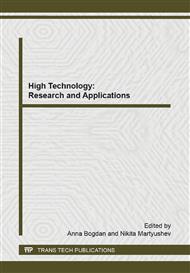[1]
W. Hajjaji, G. Costa, C. Zanelli, M.J. Ribeiro, M.P. Seabra, M. Dondi, J.A. Labrincha, An overview of using solid wastes for pigment industry, J. Eur. Ceram. Soc. 32 (2012)753–754.
DOI: 10.1016/j.jeurceramsoc.2011.10.018
Google Scholar
[2]
J.J. Reinosa, A.C. Silva, F. Rubio-Marcos, S.R.H. Mello-Castanho, J.S. Moya, J.F. Fernandez, High chemical stability of stoneware tiles containing waste metals, J. Eur. Ceram. Soc. 30 (2010) 2997–3004.
DOI: 10.1016/j.jeurceramsoc.2010.02.017
Google Scholar
[3]
F. Andreola, L. Barbieri, F. Bondioli, Agricultural waste in the synthesis of coral ceramic pigment, J. Dyes Pigments. 94 (2012) 207–211.
DOI: 10.1016/j.dyepig.2012.01.007
Google Scholar
[4]
M.J. Ribeiro, J.M.F. Ferreira, J.A. Labrincha, Extrusion of recycled pastes based on Al-rich anodising sludge, J. Key Eng. Mater. 2449 (2004) 264–8.
DOI: 10.4028/www.scientific.net/kem.264-268.2449
Google Scholar
[5]
A. Ribeiro, W. Hajjaji, M.P. Seabra, J.A. Labrincha, Malayaite ceramic pigments prepared from industrial wastes: formulation and characterization, J. Mater. Sci. Forum 636–637 (2010)1371–6.
DOI: 10.4028/www.scientific.net/msf.636-637.1371
Google Scholar
[6]
M.A. Montero, M.M. Jordán, M.S. Hernández-Crespo, T. Sanfeliu, The use of sewage sludge and marble residues in the manufacture of ceramic tile bodies, J. Appl. Clay Sci. 46 (2009)404–8.
DOI: 10.1016/j.clay.2009.10.013
Google Scholar
[7]
M. Dondi, G. Guarini, M. Raimondo, C. Zanelli, D. Dalle Fabbriche, A. Agostini, Recycling the insoluble residue from titania slag dissolution (tionite) in clay bricks, J. Ceram. Int. 36 (2010) 2461–7.
DOI: 10.1016/j.ceramint.2010.08.007
Google Scholar
[8]
R. Siddique, A. Noumowe, Utilization of spent foundry sand in controlled low-strength materials and concrete, J. Conserv. Recycling 53 (2008) 27–35.
DOI: 10.1016/j.resconrec.2008.09.007
Google Scholar
[9]
N.P. Cheremisinoff, P.N. Cheremisinoff, Hazardous materials and waste management. A Guide for the Professional Hazards Manager, William Andrew, (2005).
Google Scholar
[10]
P.T. Williams, Waste treatment and disposal, 2nd ed. England: John Wiley& Sons, (2005).
Google Scholar
[11]
R. Tilley (Ed. ). Colour and the optical properties of materials. England: John Wiley & Sons, (2000).
Google Scholar


